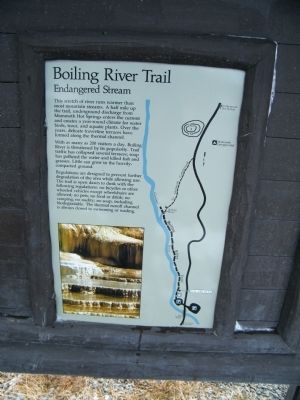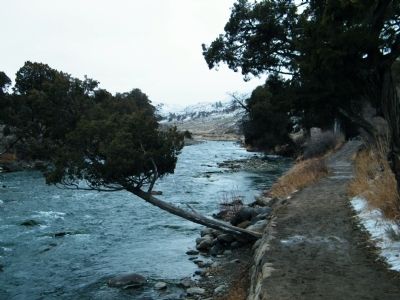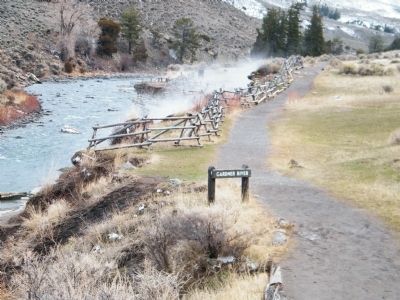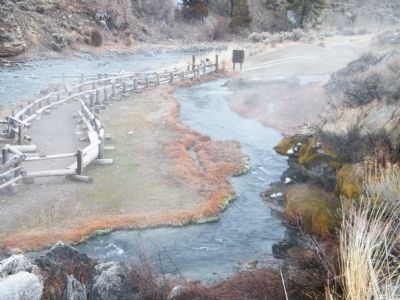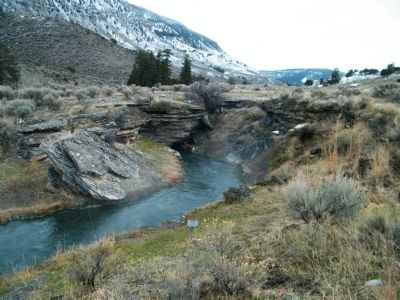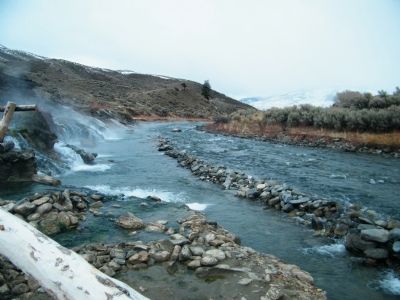Yellowstone National Park in Park County, Montana — The American West (Mountains)
Boiling River Trail
Endangered Stream
With as many as 200 visitors a day, Boiling River is threatened by its popularity. Trail traffic has collapsed several terraces; soap has polluted the water and killed fish and grasses. Little can grow in the heavily-compacted ground.
Regulations are designed to prevent further degradation of the area while allowing use. The trail is open dawn to dusk with the following regulations: no bicycles or other wheeled vehicles except wheelchairs are allowed; no pets; no food or drink; no camping; no nudity; no soap, including biodegradable. The thermal runoff channel is always closed to swimming or wading.
Erected by National Park Service.
Topics. This historical marker is listed in this topic list: Natural Features.
Location. 44° 59.543′ N, 110° 41.477′ W. Marker is in Yellowstone National Park, Montana, in Park County. Marker can be reached from North Entrance Road (U.S. 89). The sign is at a gated pull-off that leads to a parking area for the trail to Boiling River. This pull-off is just south of the bridge over Gardner River. Touch for map. Marker is in this post office area: Gardiner MT 59030, United States of America. Touch for directions.
Other nearby markers. At least 8 other markers are within 2 miles of this marker, measured as the crow flies. Mt. Everts Mudslides (approx. one mile away in Wyoming); Mail Carrier’s Cabin (approx. 1.1 miles away in Wyoming); From Soldier to Ranger (approx. 1.2 miles away in Wyoming); Road Builders (approx. 1.2 miles away in Wyoming); Fort Yellowstone (approx. 1.2 miles away in Wyoming); Elk Rut (approx. 1.2 miles away in Wyoming); Fort Yellowstone National Historic Landmark (approx. 1.2 miles away in Wyoming); The Parade Ground (approx. 1.2 miles away in Wyoming). Touch for a list and map of all markers in Yellowstone National Park.
More about this marker. The marker is almost right on the state line between Montana and Wyoming. It is part of a larger informational sign at the head of the trail to the Boiling River.
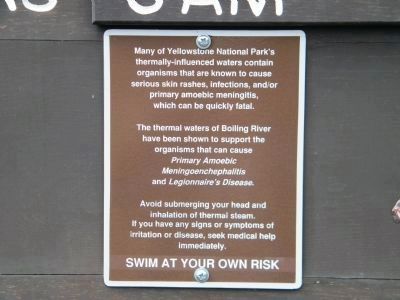
Photographed By Rich Pfingsten, March 23, 2009
7. Some of the dangers of hot springs water
Many of Yellowstone National Park's thermally-influenced waters contain organisms that are known to cause serious skin rashes, infections, and/or primary amoebic meningitis, which can be quickly fatal.
The thermal waters of Boiling River have been shown to support the organisms that can cause Primary Amoebic Meningoenchephalitis and Legionnaire's Disease.
Avoid submerging your head and inhalation of thermal steam. If you have any signs or symptoms of irritation or disease, seek medical help immediately. Swim at Your Own Risk.
The thermal waters of Boiling River have been shown to support the organisms that can cause Primary Amoebic Meningoenchephalitis and Legionnaire's Disease.
Avoid submerging your head and inhalation of thermal steam. If you have any signs or symptoms of irritation or disease, seek medical help immediately. Swim at Your Own Risk.

Photographed By Rich Pfingsten, March 23, 2009
8. Perpetual Summer informational sign on opposite side of marker sign
Ignore the calendar: this stretch of river creates its own season. In subzero weather summer-green grasses sway in the current, algae colonize pebbles, and waterfowl sometimes appear at the riverbend.
The sorcery is geothermal. Discharge from Mammoth Hot Springs percolates underground and enters the Gardner River upstream. In the tropical microclimate of plants and algae, insects feast and swarm near the surface, attracting ducks and dippers. Brown trout spawn here in December.
Along rivers throughout the park, look for breaks in winter's pattern - islands of life in the ice-locked stillness.
Inset photo caption - Here the dipper, or water ouzel, can be seen year-round. Dippers depend on open water, they feed on larvae and small fish by walking upstream underwater, using their wings for stability. Stay quiet and still, and dippers will remain nearby.
The sorcery is geothermal. Discharge from Mammoth Hot Springs percolates underground and enters the Gardner River upstream. In the tropical microclimate of plants and algae, insects feast and swarm near the surface, attracting ducks and dippers. Brown trout spawn here in December.
Along rivers throughout the park, look for breaks in winter's pattern - islands of life in the ice-locked stillness.
Inset photo caption - Here the dipper, or water ouzel, can be seen year-round. Dippers depend on open water, they feed on larvae and small fish by walking upstream underwater, using their wings for stability. Stay quiet and still, and dippers will remain nearby.
Credits. This page was last revised on September 18, 2018. It was originally submitted on February 27, 2011, by Rich Pfingsten of Forest Hill, Maryland. This page has been viewed 3,230 times since then and 15 times this year. Last updated on September 18, 2018, by Craig Baker of Sylmar, California. Photos: 1. submitted on February 27, 2011, by Rich Pfingsten of Forest Hill, Maryland. 2, 3, 4, 5, 6, 7. submitted on February 28, 2011, by Rich Pfingsten of Forest Hill, Maryland. 8. submitted on February 27, 2011, by Rich Pfingsten of Forest Hill, Maryland. • Andrew Ruppenstein was the editor who published this page.
